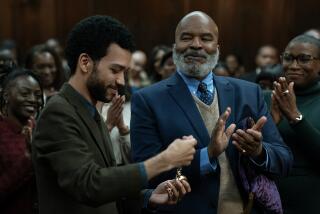Review: ‘Get on Up’ reaches for high concept instead of getting down
At 2 hours and 18 minutes, the James Brown biopic “Get On Up” runs exactly two hours longer than the knockout YouTube clip of the real Mr. Dynamite performing up a storm in 1964’s “The T.A.M.I. Show.” It is not time well spent.
Despite the linked advantages of generous helpings of the man’s high octane music and a star performance by Chadwick Boseman that’s little short of heroic, “Get on Up” is more frustrating than fulfilling, a disjointed film that suffers from having a more ambitious plan than it’s got the ability to execute.
It’s not at all obvious, actually, that the too-cool-for-school high-concept script by the British brother team of Jez Butterworth and John-Henry Butterworth would work no matter who was behind the camera.
What is clear, however, is that letting director Tate Taylor have a crack at it was unfortunate. An indifferent filmmaker who got industry traction after his debut, “The Help,” struck it rich, Taylor lacks the grasp and sophistication to make the Butterworths’ iffy script workable.
The Butterworths, who perhaps felt it was boring and beneath them to do something as pedestrian as a conventional Hollywood biopic, came up with a script that is anti-linear with a vengeance.
Episodes from Brown’s life, some labeled by year, some not, are put on screen in what plays like completely arbitrary, non-chronological order. Further scenes, like a reunion between Brown and the mother who abandoned him (Viola Davis, effective as always), are broken up into sections that are placed as far from each other as possible. Adding to the confusion are sporadic moments when Brown breaks the fourth wall and talks directly to the audience.
It’s possible the “Get on Up” team thought this narrative chaos was a way to convey how perplexing and confounding a personality Brown was, a self-created individual who maneuvered his way from dire poverty to enormous success but ended up being serially abusive to individuals, whether they be band members or the women in his life, who didn’t live up to his own exacting standards.
But, when combined with Taylor’s lack of subtlety and instinct for the obvious, that lack of focus eliminates narrative drive and coherence, distancing us from an already dicey story and robbing us of whatever potential the tale has to get us to empathize with its difficult protagonist.
It’s a mark of how galvanizing a star Boseman is that his moment-to-moment performance, the energy and intelligence he brings to his work as a man who ran roughshod over adversity (“I take it and I flip it,” he says. “I go forward”), convinces you despite all the obstacles the film’s structure places in his way.
Boseman, who came to prominence playing Jackie Robinson in “42,” does not sing Brown’s songs, but, aided by choreographer Aakomon Jones, he does perform a ton of them. Not only can he expertly handle the steps and the splits, but the 50 dazzling costume changes designed by Sharen Davis and wig consultant Robert Stevenson’s nine hairpieces ensure that he looks the part as well.
It’s typical of the filmmakers’ point of view that “Get on Up” begins with a particularly confounding scene from 1988 in which a borderline incoherent, shotgun-toting Brown harangues a group of insurance agents renting space in one of his Augusta, Ga., buildings about the inadvisability of using his personal toilet and ends up being chased across two states by Georgia and South Carolina law enforcement.
After that comes a whole range of non-chronological episodes from Brown’s past, going as far back as his difficult, impoverished childhood and the time, after both his parents abandoned him, that he spent living with an aunt (Octavia Spencer) who ran a bordello. “You special, boy,” Aunt Honey tells him in a typical dead-on line. “You got the spirit in you.”
“Get on Up” covers many key moments of the singer’s adult life, including his decision to put his own money into the hugely successful “Live at the Apollo” album after no one else believed in it, and his participation in that legendary 1964 T.A.M.I. show at the Santa Monica Civic when promoters foolishly insisted that the Rolling Stones, and not Brown, close the show.
We also are in the house when Brown meets Bobby Byrd (Nelsan Ellis), who was to become his closest musical collaborator, after Byrd’s Gospel Starlighters group played a prison where young Brown was an inmate.
Not only are these and “Get on Up’s” other episodes presented out of sequence, they also vary greatly in quality. A scene of a racist blindfolded boxing match Brown was forced to participate in as a boy couldn’t be more heavy-handed, but having the singer address the audience about how he plans to control the business of his concerts as well as the show takes full advantage of Boseman’s charisma.
James Brown was a man with an instinct for the spotlight and, Boseman’s performance aside, it’s a shame this film doesn’t share that gift.
------------
MPAA rating: PG-13 for sexual content, drug use, some strong language and violent situations
Running time: 2 hours, 18 minutes
Playing: In general release
More to Read
Only good movies
Get the Indie Focus newsletter, Mark Olsen's weekly guide to the world of cinema.
You may occasionally receive promotional content from the Los Angeles Times.







